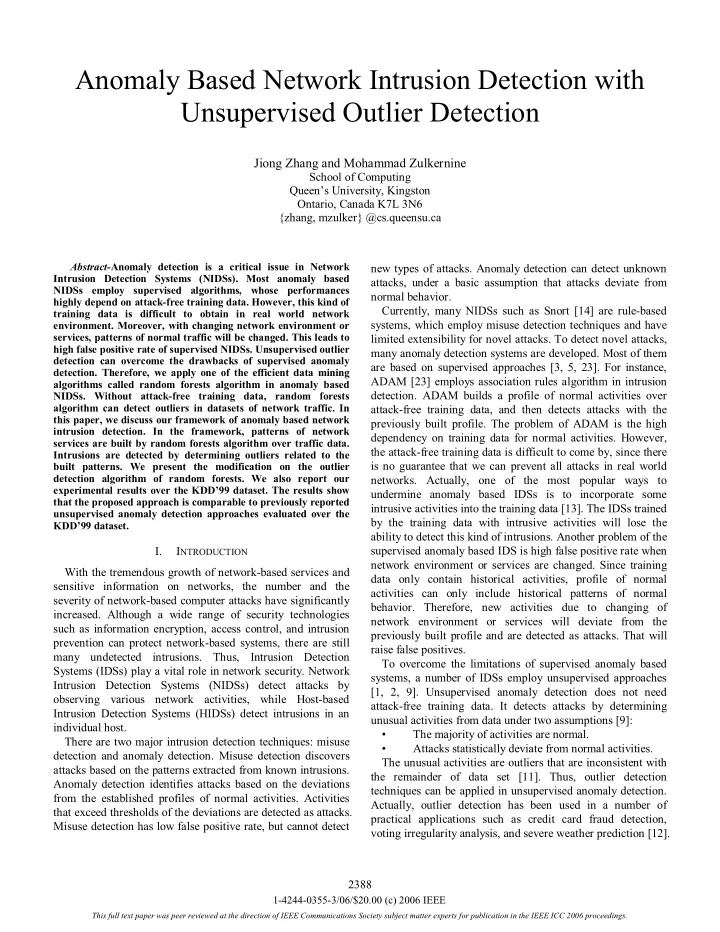

Anomaly Based Network Intrusion Detection with Unsupervised Outlier Detection Jiong Zhang and Mohammad Zulkernine School of Computing Queen’s University, Kingston Ontario, Canada K7L 3N6 {zhang, mzulker} @cs.queensu.ca Abstract- Anomaly detection is a critical issue in Network new types of attacks. Anomaly detection can detect unknown Intrusion Detection Systems (NIDSs). Most anomaly based attacks, under a basic assumption that attacks deviate from NIDSs employ supervised algorithms, whose performances normal behavior. highly depend on attack-free training data. However, this kind of Currently, many NIDSs such as Snort [14] are rule-based training data is difficult to obtain in real world network systems, which employ misuse detection techniques and have environment. Moreover, with changing network environment or services, patterns of normal traffic will be changed. This leads to limited extensibility for novel attacks. To detect novel attacks, high false positive rate of supervised NIDSs. Unsupervised outlier many anomaly detection systems are developed. Most of them detection can overcome the drawbacks of supervised anomaly are based on supervised approaches [3, 5, 23]. For instance, detection. Therefore, we apply one of the efficient data mining ADAM [23] employs association rules algorithm in intrusion algorithms called random forests algorithm in anomaly based detection. ADAM builds a profile of normal activities over NIDSs. Without attack-free training data, random forests algorithm can detect outliers in datasets of network traffic. In attack-free training data, and then detects attacks with the this paper, we discuss our framework of anomaly based network previously built profile. The problem of ADAM is the high intrusion detection. In the framework, patterns of network dependency on training data for normal activities. However, services are built by random forests algorithm over traffic data. the attack-free training data is difficult to come by, since there Intrusions are detected by determining outliers related to the is no guarantee that we can prevent all attacks in real world built patterns. We present the modification on the outlier detection algorithm of random forests. We also report our networks. Actually, one of the most popular ways to experimental results over the KDD’99 dataset. The results show undermine anomaly based IDSs is to incorporate some that the proposed approach is comparable to previously reported intrusive activities into the training data [13]. The IDSs trained unsupervised anomaly detection approaches evaluated over the by the training data with intrusive activities will lose the KDD’99 dataset. ability to detect this kind of intrusions. Another problem of the I. I NTRODUCTION supervised anomaly based IDS is high false positive rate when network environment or services are changed. Since training With the tremendous growth of network-based services and data only contain historical activities, profile of normal sensitive information on networks, the number and the activities can only include historical patterns of normal severity of network-based computer attacks have significantly behavior. Therefore, new activities due to changing of increased. Although a wide range of security technologies network environment or services will deviate from the such as information encryption, access control, and intrusion previously built profile and are detected as attacks. That will prevention can protect network-based systems, there are still raise false positives. many undetected intrusions. Thus, Intrusion Detection To overcome the limitations of supervised anomaly based Systems (IDSs) play a vital role in network security. Network systems, a number of IDSs employ unsupervised approaches Intrusion Detection Systems (NIDSs) detect attacks by [1, 2, 9]. Unsupervised anomaly detection does not need observing various network activities, while Host-based attack-free training data. It detects attacks by determining Intrusion Detection Systems (HIDSs) detect intrusions in an unusual activities from data under two assumptions [9]: individual host. • The majority of activities are normal. There are two major intrusion detection techniques: misuse • Attacks statistically deviate from normal activities. detection and anomaly detection. Misuse detection discovers The unusual activities are outliers that are inconsistent with attacks based on the patterns extracted from known intrusions. the remainder of data set [11]. Thus, outlier detection Anomaly detection identifies attacks based on the deviations techniques can be applied in unsupervised anomaly detection. from the established profiles of normal activities. Activities Actually, outlier detection has been used in a number of that exceed thresholds of the deviations are detected as attacks. practical applications such as credit card fraud detection, Misuse detection has low false positive rate, but cannot detect voting irregularity analysis, and severe weather prediction [12]. 2388 2388 1-4244-0355-3/06/$20.00 (c) 2006 IEEE This full text paper was peer reviewed at the direction of IEEE Communications Society subject matter experts for publication in the IEEE ICC 2006 proceedings.
Recommend
More recommend